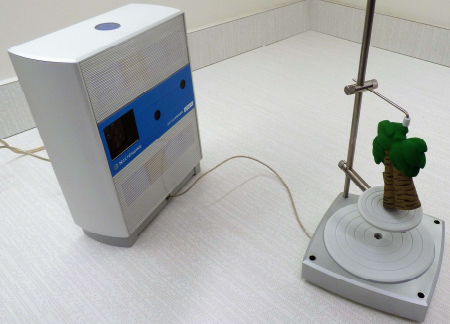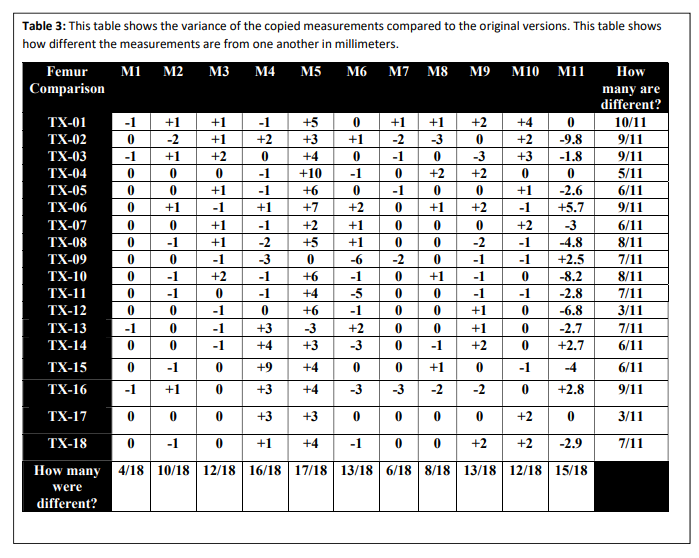University of Montana: Analyzing Accuracy of 3D Printed Femurs for Forensic Anthropology and Bioarchaelogy
 Thesis student Myriah Adonia Jo Allen (University of Montana) discusses not only the implications of 3D scanning and 3D printing overall, but more specifically, how important the technology of 3D printing an item like a proximal right femur can be for anthropologists and bioarcheologists—and whether they can really be fabricated identically. The researcher’s findings are outlined in the recently published ‘3D Printing of the Proximal Right Femur: Its Implications in the Field of Forensic Anthropology and Bioarchaelogy.’
Thesis student Myriah Adonia Jo Allen (University of Montana) discusses not only the implications of 3D scanning and 3D printing overall, but more specifically, how important the technology of 3D printing an item like a proximal right femur can be for anthropologists and bioarcheologists—and whether they can really be fabricated identically. The researcher’s findings are outlined in the recently published ‘3D Printing of the Proximal Right Femur: Its Implications in the Field of Forensic Anthropology and Bioarchaelogy.’
Preservation of relics and skeletal collections is a process that is continually being refined with new techniques and technologies. The author expresses grave concern for the safety of skeletal remains, especially after the catastrophes at both the Brazil National Museum and the Notre Dame cathedral—with fires causing great loss.
“Over the next few decades, many skeletal remains from across the globe will be removed from various collections and will then be given back to the claimants or put up where one cannot touch them. This results in fewer supplies that can be utilized for research purposes; therefore, it is necessary to retain information from the remains in as many ways as possible before they wither get returned or worse destroyed.”

The NextEngine Scanner being calibrated utilizing the palm tree
In this thesis study, Allen examined 18 different proximal right femoral ends obtained from the Forensic Anthropology Center at Texas State University. Referring to past research in replication of skeletal remains, the author points out that a variety of different materials have been used over the years with good accuracy; in fact, some have been good enough for use in the courtroom even, giving juries the chance to inspect copies of evidence—and providing forensics analysts and labs with a new technological resource on which to rely.
3D technology has added an interesting boost to biological archaeology also, in a range of different exhibits, museums, and learning institutions. One of the greatest benefits today is that museumgoers and other enthusiasts can touch 3D printed replicas without threatening the integrity of items that could be ancient and extremely fragile. Archaeologists and students can also enjoy handling delicate works without endangering them.
The femurs involved in the study were composed of a ‘mixed data set,’ with little deterioration. Allen chose to study this bone regarding 3D printing because so much data can be taken in from this small area. Using calipers and measuring tape, Allen took 11 sets of measurements for each femur in the study, as follows:
- Maximum head diameter
- Anterior-posterior (sagittal) subtrochanteric diameter (M2)
- Medial-lateral (transverse) subtrochanteric diameter (M3)
- Circumference of the head
- Neck circumference
- Superior neck length
- Anterior-posterior neck diameter
- Superior-inferior neck diameter
- Coronal oblique plane/ upper epiphyseal length
- Measurement of the intertrochanteric crest length
- Platymeric Index
 Items were then scanned and converted for 3D printing on a MakerBot, using PLA. Once support materials were removed, Allen measured them, comparing to the originals and analyzing any differences or errors, noting ‘an exciting find’ as upon comparing Table 2 and Table 3, there were only tiny differences—by a few millimeters.
Items were then scanned and converted for 3D printing on a MakerBot, using PLA. Once support materials were removed, Allen measured them, comparing to the originals and analyzing any differences or errors, noting ‘an exciting find’ as upon comparing Table 2 and Table 3, there were only tiny differences—by a few millimeters.
“Even if some differences did occur, most likely due to intraobserver error this method does show statistical significance to be able to be utilized for accuracy. However, no constant error rate can be seen during the analysis. Therefore, this method has proved itself to be a useful method for the fields of forensic anthropology not only in terms of presenting to a jury, but also in terms of examination. As for bioarcheology, this method can also be useful in terms of preservation of archaeological remains that are currently on display in many countries around the world,” concluded the author.

This image constitutes of a group of 3D printed femurs. TX-16, on the far left and it shows that the print must be monitored every so often or else the printer might run out of filament and a change has to occur midprint. TX-17 in the middle left shows fall outs or little bumps on its surface because the extruder-point on the printer released too much filament at once, but it did not affect the overall measurements. TX-12 in the middle right shows what happens when the print gets too big for the printer. Lastly, TX-14.2 is another print taken of TX-14 to show what can happen when the printer arithmetically inputs structures.
What do you think of this news? Let us know your thoughts! Join the discussion of this and other 3D printing topics at 3DPrintBoard.com.
Subscribe to Our Email Newsletter
Stay up-to-date on all the latest news from the 3D printing industry and receive information and offers from third party vendors.
Print Services
Upload your 3D Models and get them printed quickly and efficiently.
You May Also Like
The Dental Additive Manufacturing Market Could Nearly Double by 2033, According to AM Research
According to an AM Research report from 2024, the medical device industry, specifically in dentistry, prosthetics, and audiology, is expected to see significant growth as these segments continue to benefit from...
Heating Up: 3D Systems’ Scott Green Discusses 3D Printing’s Potential in the Data Center Industry
The relentless rise of NVIDIA, the steadily increasing pledges of major private and public investments in national infrastructure projects around the world, and the general cultural obsession with AI have...
AM Research Webinar Explores Continuum’s Sustainable Metal Additive Manufacturing Powders
Metal additive manufacturing (AM) powder supplier Continuum Powders is working to develop solutions that empower industries to reduce waste and optimize their resources. An independent life cycle assessment (LCA) of...
3D Printed Footwear Startup Koobz Lands $7.2M in Seed Round
California-based Koobz is focused on reshoring the U.S. footwear supply chain with advanced manufacturing processes, including 3D printing. The startup just announced that it has added $6 million to its...


































